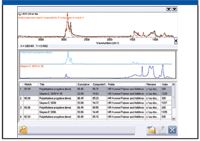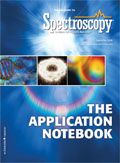Complete Analysis of Carbon Black–Containing Rubbers
Carbon black rubbers often contain multiple components, but are strongly absorbing in the infrared. The combination of Ge ATR, Advanced ATR correction and multi-component searching permits the full analysis of these important materials.
Carbon black rubbers often contain multiple components, but are strongly absorbing in the infrared. The combination of Ge ATR, Advanced ATR correction and multi-component searching permits the full analysis of these important materials.
Carbon black rubbers (CBRs) are present in tires, gaskets, o-rings and many other heavy-wear applications. CBRs are typically resilient, with the carbon black conducting heat efficiently, extending tire tread or gasket life. CBRs have traditionally been difficult to analyze by IR, as they are opaque even when cut extremely thinly. More critically for ATR, CBRs have a high index of refraction. Thus, near strong absorption bands, the sample refractive index may approach or exceed the refractive index for the ATR crystal (such as diamond or ZnSe), resulting in badly distorted spectra which cannot easily be corrected. However, Ge ATR spectra show clean and well-defined peaks, due to the much higher index of refraction for Ge, and the resulting shallow depth of penetration of the IR beam into the CBR.
The analytical situation is further complicated by the presence of multiple components in the CBR. Traditional analyses have required subtraction steps, requiring reference spectra of the pure constituents taken under the same conditions. Recently developed tools provide the ability to correct the ATR spectra completely, allowing the use of standard transmission libraries, and then to analyze the spectrum using a simultaneous searching mechanism. Since subtractions are not required, the analyst can proceed without any special knowledge of the sample or skills in using subtraction routines.
Experimental Conditions
The sample originated from an automobile window gasket. A Thermo Scientific Nicolet™ iS™10 FT-IR spectrometer equipped with a Smart iTR™ germanium ATR was used to collect spectra. Data were transferred to OMNIC™ Specta™ software for all processing and multi-component searching.
Results
The raw spectrum of the CBR was first baseline corrected, then the Advanced ATR Correction (1) was applied. This correction accounts for both the frequency dependence of the depth of penetration and the changing refractive index of the sample in the vicinity of a strong absorption band. The resulting spectrum can then be searched against standard transmission libraries, regardless of which ATR crystal is used. However, the CBR is clearly a multi-component sample, as can be seen from the spectrum in the figure. A simple search does return the base polymer, but the sizeable peaks around 1000 cm–1 are not matched.
Figure 1 shows the result of a multi-component search. The algorithm (2) extracts two components from this CBR — the base polymer and a silane. Recalling the origin of the sample as a window gasket, the silane prevents sticking of the window to the gasket as it opens and closes. An analysis of the inside of the gasket does not show the silane — none is needed there.

Figure 1: The multi-component search result for a CBR. The silane has been clearly identified, along with the base polymer.
Conclusion
Carbon black rubbers represent a challenging IR sample. Ge ATR, Advanced ATR Correction and multi-component searching combine to simplify the process. As this is all automated, the process is robust and reproducible regardless of the skill level of the user.
References
(1) Simon Nunn and Koichi Nishikida, Thermo Fisher Scientific Application Note AN 01153.
(2) Garry Ritter and Michael Bradley, Thermo Fisher Scientific Technical Note TN51506.

Thermo Fisher Scientific
Madison, WI 53711
1-800-532-4752

Thermo Fisher Scientists Highlight the Latest Advances in Process Monitoring with Raman Spectroscopy
April 1st 2025In this exclusive Spectroscopy interview, John Richmond and Tom Dearing of Thermo Fisher Scientific discuss the company’s Raman technology and the latest trends for process monitoring across various applications.
A Seamless Trace Elemental Analysis Prescription for Quality Pharmaceuticals
March 31st 2025Quality assurance and quality control (QA/QC) are essential in pharmaceutical manufacturing to ensure compliance with standards like United States Pharmacopoeia <232> and ICH Q3D, as well as FDA regulations. Reliable and user-friendly testing solutions help QA/QC labs deliver precise trace elemental analyses while meeting throughput demands and data security requirements.